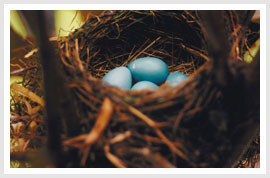Environmental Protection
Big Bear Fire is dedicated to protecting the Big Bear communities from wildfire and is mutually supportive of protecting the environment. This includes specifically protecting sensitive plants and nesting birds.
To accomplish this, homeowners are encouraged to identify sensitive plants on their property before they conduct any kind of removal and/or modification of flammable shrubs i.e., Juniper Bushes, Spanish Broom, Manzanita, Mountain Mahogany, Mountain Whitethorn, Service Berry, Black Sage or White Sage. These shrubs are not endangered or sensitive.
Sensitive Plants
Examples of sensitive plants include Cushenbury Oxytheca, Cushenbury Milk-Vetch, Parish's Daisy, Cusenbury Buckwheat, Ash-Indian Paintbrush, Frosted Mint, San Bernardino Mountain Bladderpod, Big Bear Valley Sandwort, Southern Mountain Buckwheat, San Bernardino Blue Grass, Bird-Foot Checkerbloom, California Dandelion, and Slender-Petaled Thelypodium. The City of Big Bear Lake Planning Department maintains maps of the Sensitive Plant area and can help you identify sensitive plants. The Planning Department can be reached at 909-866-5831. Homeowners should note that the above plants are not identified as flammable or native plants that need removal or modification in order to protect the community from ravishes of a wildfire.
For pictures of these plants go to www.fs.fed.us/wildflowers/Rare_Plants/profiles/pacificsouthwest.shtml
Nesting Birds
Steps homeowners can take to protect nesting birds: Step One: Before modifying shrubs on your property, identify bird nests located within any of the shrubs identified that require modification or removal. These shrubs include: Juniper Bushes, Spanish Broom, Manzanita, Mountain Mahogany, Mountain Whitethorn, Service Berry, Black Sage or White Sage.
Step One: Before modifying shrubs on your property, identify bird nests located within any of the shrubs identified that require modification or removal. These shrubs include: Juniper Bushes, Spanish Broom, Manzanita, Mountain Mahogany, Mountain Whitethorn, Service Berry, Black Sage or White Sage.
Step Two: Check to see if it is an active nest and not a nest left from previous years.
Step Three: If you are modifying greater than 20 flammable shrubs between (March 15 and August 15) on your property, a Nesting Bird Survey may be required. Experience has taught us that most generally, less than 20 shrubs are modified or removed on any one property as a result of a fire hazard abatement.
Step Four: If you are conducting fuels modification work on less than 20 plants, check to see if you have a nesting bird in any of the plants subject to removal and or modification.
If there is an active nest, conduct work on all other shrubs which are located greater than 25 feet away from the active bird nests. If you are a property owner who is required to modify or remove native brush and shrubs as a result of a Fire Hazard Abatement Notice and you have a nesting bird(s), you may need to contact the Agency that issued the Hazard Abatement Notice and ask for an extension, or wait to modify the plant after the young have fledged.
